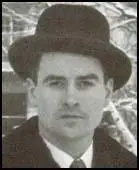Raymond G. Leddy

Raymond Leddy was born in New York City. He was educated at Xavier High School, Holy Cross College and Fordham University Law School.
Leddy joined the FBI and during the Second World War he was sent to Cuba where from February 1943 he served in the U.S. Embassy in Havana. His assistant was Winston Scott. He later recalled that "he (Leddy) was well-educated, had good, even if accented, Spanish - and he had a car." The two men became close friends.
After the war Leddy launched his own import-export business, the North American Transatlantic Corporation. However, in 1948 he joined the Central Intelligence Agency and took part in the fight against communism in Venezuela. During this period he met and married Janet Graham.
According to a fellow agent: "He (Leddy) was very smooth, polished, and a good man to work for." As Jefferson Morley pointed out in his book, Our Man in Mexico (2008): "Before long Leddy was the chief of OPC operations for the whole hemisphere."
In 1954 Leddy joined forces with Frank Wisner, David Atlee Phillips, Tracy Barnes, E.Howard Hunt and William (Rip) Robertson in Operation Success, a plan to overthrow Jacobo Arbenz, the president of Guatemala. One CIA memo has Leddy saying: "It may be necessary to take more deadly plans might need development... The best way to bring about the fall of the Arbenz government would be to eliminate 15-20 of its leaders with Trujillo's trained pistoleros."
The CIA bribed Arbenz's military commanders. It was later discovered that one commander accepted $60,000 to surrender his troops. Ernesto Guevara attempted to organize some civil militias but senior army officers blocked the distribution of weapons. Arbenz now believed he stood little chance of preventing Castillo gaining power. Accepting that further resistance would only bring more deaths he announced his resignation over the radio.
The new government formed by Colonel Carlos Castillo was immediately recognised by President Dwight Eisenhower. Castillo now reversed the Arbenz reforms. In July 19, 1954, he created the National Committee of Defense Against Communism and decreed the Preventive Penal Law Against Communism to fight against those who supported Arbenz when he was in power. Over the next few weeks thousands were arrested on suspicion of communist activity. A large number of these prisoners were tortured or killed.
The new government disenfranchised three-quarters of Guatemala's voters by barring illiterates from the electoral rolls. Castillo also outlawed all political parties, trade unions and peasant organizations. Opposition newspapers were closed down and "subversive" books were banned and existing copies were burnt in the streets.
In 1957 Leddy was sent to Mexico City. This enabled him to renew his friendship with Winston Scott, who was now CIA's station chief in Mexico. In December 1958, Leddy and Scott initiated operation LITEMPO, a network of paid agents and collaborators. This included Adolfo Lopez Mateos, Luis Echeverria, Fernando Gutiérrez Barrios and Diaz Ordaz. The CIA promoted the political careers of these men. The agency also arranged for taps on the phones used by political rivals such as Lazaro Cardenas and Vicente Lombardo Toledano.
After Fidel Castro took power in Cuba, Leddy coordinating a report from the "intelligence community" declaring that Castro was "pro-Communist and his advisers either communist or Pro-Communist". Leddy also testified to the Senate Internal Security Subcommittee about the threat of Castro".
Winston Scott was asked by Allen W. Dulles to use his LITEMPO to help overthrow the government. Adolfo Lopez Mateos, who was now president of Mexico resisted this idea. He told Dulles: "There is a lot of sympathy for Castro and his revolution in Mexico. This factor has to be weighed by me in all actions concerning Cuba. For this reason Mexico cannot take any overt action." Lopez Mateos added that covert action was a different matter. "There are many things we should be able to do under the table."
In 1961 Winston Scott began an affair with Janet Leddy. When he discovered what was going on, Raymond Leddy took a job at the Army War College in Carlisle, Pennsylvania. Brian Bell, who worked under Leddy: "It was too bad because he was one of the most competent political officers I ever met in the Foreign Service."
Paula Murray Scott also discovered about the affair and began drinking heavily. On 12th September, 1962, Paula was found dead in her home. Her death certificate said that she had died of a "heart attack intestinal tuberculosis". As Jefferson Morley points out: "That contradictory diagnosis was not what a physician would have written. Paula did have intestinal tuberculosis, but such a condition could not have caused death." Later evidence emerged that suggested that she either committed suicide or was murdered. Whatever happened, Scott would have had little difficulty in arranging for a Mexican doctor to say that his wife died of a heart attack.
Janet Leddy immediately obtained a divorce and in December 1962 became Winston Scott's third wife. One of Paula's friends at the Chapultepec Golf Club commented: "It was like he married the motive." Thomas C. Mann, David Atlee Phillips, Adolfo Lopez Mateos and Diaz Ordaz attended the wedding.
Leddy filed suit against his wife in a Mexican court for "abandonment". He demanded custody of their five children. He also tried unsuccessfully to use his influence in the State Department to have Winston Scott transferred back to the United States.
Raymond Leddy died in Carlisle on 5th March, 1976.

